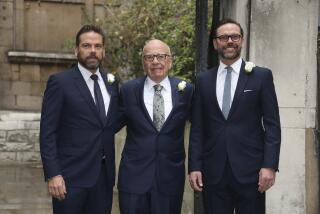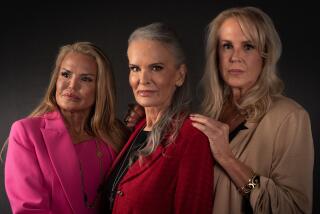2 Nixon Daughters, 1 Big Feud
- Share via
The body of Richard Milhous Nixon was scarcely in the ground when the struggle for control of his legacy had begun. It was April 28, 1994. His grieving daughters and their husbands were bound from the El Toro Marine base to New York on the plane that once served as their father’s Air Force One.
They were a comfortable foursome that had practically grown up together: Tricia and Julie--inseparable in youth, maids of honor at each other’s weddings--and the sons-in-law who melted seamlessly into the Nixon clan, feeding the patriarch’s hunger for political discourse at every Christmas gathering.
For the record:
12:00 a.m. April 25, 2002 FOR THE RECORD
Los Angeles Times Thursday April 25, 2002 Home Edition Main News Part A Page 2 A2 Desk 1 inches; 20 words Type of Material: Correction
Nixon children--Former President Nixon was 81 when he died in 1994. The wrong age was given in a story in Tuesday’s Section A about his daughters.
The disgraced former president had spent his final years polishing his tarnished image as his daughters retreated to their separate lives. On the day he was buried at the presidential library in Yorba Linda, his funeral appeared to be a national rite of forgiveness. Every living president lined up to mourn him. He was hailed as a statesman. The nine-acre library and birthplace memorialize his rise from country lawyer to the commander in chief.
But that day on the plane, the dark forces that haunted Nixon in life seemed to reach beyond the grave. Somewhere between the two coasts, Edward Cox, Tricia’s New York attorney husband, brought up a plan to ensure the Nixon library would be tightly controlled by the family rather than by hired hands.
While the subject might have seemed innocuous enough, Cox had touched a nerve that would bitterly divide the Nixon sisters as they struggled to sort out how much of their father’s legacy belonged to history and how much belonged to them.
Years of mudslinging, perceived slights and betrayals followed that cross-country journey home, and finally, a pair of lawsuits filed earlier this year pitted one sister against the other. Today, they do not speak. The library their father hoped the sisters would co-direct showcases Julie and shuns Tricia, who tells friends she has not been invited there in five years.
This gardened place the exiled president worked so hard to build is better known for wedding parties than for serious research. It still does not house his presidential papers. And two lawsuits are pending over a $19-million bequest from his dearest friend.
“It’s beyond tragic. I couldn’t imagine facing the old man in this situation,” Kenneth L. Khachigian, a Nixon confidant for decades, said of the rift. “He would be crestfallen.”
For most of their lives, Nixon’s daughters were bonded by love and crises. Now in their 50s, their common goal is a library that preserves the positive legacy of their father’s presidency, from relations with China to detente with Russia. Yet, they disagree about how that should be managed--and by whom.
Friends and family believe the sisters’ loyalty was undermined by a defiant library director, sons-in-law with career ambitions, Nixon disciples eager to claim their piece of one president’s legacy--all pointing to each other in a riot of blame.
But like so many sibling rivalries, this rift may have its roots in the personalities of two very different women, mirror opposites in youth, linked by devotion to their famously troubled father.
The tale of their struggle is purely Nixonian: a man whose obsession with political power undermined his presidential vision. Now his daughters’ battle for control is jeopardizing his legacy. And their shared desire to put the Nixon scandals in proportion to the Nixon successes has resurrected some of the ugliness they sought to bury.
Daughters Stand by Father With Love
They were model little girls in starched coats and hats, one blond and round-faced, the other dark-haired and angular. Their father may have been Dwight D. Eisenhower’s vice president, but Pat Nixon made sure her daughters knew how to grocery shop and use a steam iron.
Whatever the public thought of Nixon, his children reflected a loving father whose daughters stood by him in triumph and shame. When campus protesters painted him a heartless warmonger, Tricia recast him as father of the bride and shifted the nation’s eyes to her Lenox china pattern and her Rose Garden wedding. When the shame of Watergate engulfed him three years later, a defiant Julie defended him to the world.
They attended prestigious private schools and were the centerpiece of the Washington social scene, but they paid the inevitable price. As a sophomore at liberal Smith College in Massachusetts, Julie participated in a mock Republican convention where no one would volunteer to play her father and students jeered at the mention of his name.
“It was hell on Earth for me,” she wrote in her published diary. Threatened protests kept her from her graduation. And the stigma of Watergate kept her from running for office in Pennsylvania. Still, she remained one of his most ardent public defenders.
Tricia rarely spoke openly--the White House press corps dubbed her the “Mystery Princess”--but her loyalty to her father was no less steadfast. She stayed close to home, choosing Finch College in New York while he practiced law there. Nearly 23, she moved with her parents to the White House in his first term (the younger Julie was already married). It was Tricia who marshaled the family, arms locked, for a final White House news photo as the scandal expelled them from Washington.
“They were important to Nixon from the beginning of time,” said Leonard Garment, special counsel to Nixon during Watergate. “They were attractive, engaging, stable young ladies and that spoke well for Nixon as a parent and as a human being.”
When Nixon’s wild ride finally ended, his daughters seemed to welcome a reprieve from the harsh limelight.
For Tricia, that meant a life of chosen obscurity as the wife of a corporate lawyer. The Coxes lived off Fifth Avenue in Manhattan in an apartment of chintz fabrics, Oriental rugs and family photographs in tasteful numbers. When she was spotted in public, it was in suits and heels, impeccably groomed, her blond hair pulled back and fur draping her shoulders. The couple, quintessential New Yorkers, didn’t own a car.
For Julie, a busy soccer mom in a one-story farmhouse in Berwyn, Pa., life was piling the kids into the family wagon. She and her husband, David Eisenhower, wrote books--he also lectured at the University of Pennsylvania--and life was consumed by homework and Little League.
Those were good years of relative privacy. In the backyard of the big house in Saddle River, N.J., where Richard and Pat Nixon had retired on four acres, there was whiffle ball and swimming, Chinese takeout and plays staged by the four grandchildren. Holidays were an all-family affair.
The daughters spoke every day as they shepherded their ailing parents through old age. Tricia nursed Pat Nixon after her stroke. Julie amused her father with stories about his grandchildren. Together, they buried them both.
But Richard Nixon’s death left his daughters to sort out a tangle of controversial bequests and hard decisions about the future of the Nixon Foundation that runs the library and birthplace. Their allegiance to their father had always been primary, and when he died, their allegiance to each other was tested as never before.
The potential for disagreement faced them daily, whether over tax ramifications or how to spend the foundation’s endowment. Said one person close to the family who, like most others interviewed for this story, spoke anonymously to avoid publicly taking sides or jeopardizing pending lawsuits: “We regard presidential offspring as royalty, but we don’t completely subsidize them the way the Brits do, so they’re caught between selling what is bequeathed to them or acknowledging that in some way it belongs to history.”
Nixon’s Heirs Spend Years in Disputes
In the last years of his life, Nixon was forever dashing off memos to the Oval Office or meeting with some foreign head of state at Tricia’s Manhattan apartment. “Write me an essay on whether the U.S. should help Gorbachev!,” he would kindly command his young researcher, Monica Crowley.
The ailing president was on a mission to repair his reputation, finish his memoirs and build his library. Before he died at 80, he did it all. Almost.
Despite Nixon’s painstakingly detailed will, his heirs would spend years figuring out how to run the library and how to get back the presidential papers, seized by the federal government, after he resigned to ensure they weren’t destroyed. They worried about whopping estate taxes. A bequest from an old Nixon friend who had made anti-Semitic remarks was shaping up as a public relations embarrassment.
But whatever tension there was over the library’s future seemed to exist more between the two couples and John Taylor, the ambitious executive director handpicked by Nixon, than between the sisters themselves.
By the end of 1996, Tricia and Julie were equally disenchanted with Taylor and wanted him fired. They wrote a letter accusing him of refusing to take their calls and objecting to his plan to reduce family control of the library.
“We will carry out our father’s wish that his family play a decisive role in the governance of his library and Foundation,” they wrote. They dispatched longtime Nixon friend Khachigian to fire Taylor, who resisted, threatening to bring a lawsuit and mounting a campaign to save his job, Khachigian said.
By then the library was in utter turmoil. One board member resigned in the winter of 1997, saying the foundation had become a “plaything of the family.” Edward Cox seemed to be on a campaign against Taylor, convinced he was trying to hijack the library. Taylor was building his own case against Cox, accusing him of making abusive late-night telephone calls to the library staff and demanding protection from estate taxes.
The unrest cost the library dearly. A $5-million bequest by the late pharmaceutical tycoon Elmer Bobst was withdrawn by his widow as Nixon friends and family debated whether anti-Semitic comments by the donor would embarrass the library. A $26-million offer from the federal government that would have returned Nixon’s presidential papers and paid for a building to house them was scuttled by his daughters, who feared high estate taxes.
Even so, the solidarity between Tricia and Julie remained intact.
Then something changed. Sometime between December 1996 and the following May, Julie switched her allegiance from her sister to Taylor. Without apparent explanation, she signed an agreement to expand the board, giving herself and her sister no more weight than any of the other 22 members.
The couples were now divided into two camps: The Coxes, who want the Nixon family to control the major decisions regarding the library, including its budget, and the Eisenhowers, who want an empowered professional staff and an independent board of directors with Julie and Tricia on it.
In retrospect, the seemingly innocuous conversation on that retired Air Force One out of El Toro took on new meaning. Cox has described the remarks he made about family control of the library as “offhand.” But the Eisenhowers felt exploited in their time of grief, friends said.
Eight years later, things have only gotten worse. With Julie’s blessing, the Nixon Foundation filed a lawsuit in California ordering her sister to sign off on a $19-million bequest from Nixon’s longtime friend, the late Bebe Rebozo. A companion suit filed in Florida is suing the Rebozo estate to force it to relinquish the much-needed money, stuck for years in a probate court because of the disagreement. Judges in both cases have urged the family to settle the matter out of court.
Friends say Tricia has been effectively cut out of the library’s inner circle. While the staff disputes that contention, her identity has clearly devolved into a sideshow attraction best remembered for her Rose Garden wedding and the cake of 400 egg whites: “Picture yourself being married near the very gazebo that Tricia Nixon Cox was married under in the White House Gardens . . . “ the library Web site beckons.
By contrast, Julie is a library ambassador. Just last month, Taylor and the Eisenhowers went to China in commemoration of her father’s historic diplomacy there 30 years ago.
Whatever made Julie break from her sister is not clear. Both refused to be interviewed. But there is evidence that Julie was lobbied hard by other board members that winter of 1997 to spare Taylor’s job and cut the family’s influence--including her own--in the running of the library.
“Total hoo-ha,” said Taylor, who contends Julie was never lobbied. She decided to support him 24 hours after she attempted to fire him, he said.
But others believe an important influence was Walter Annenberg, the publishing magnate and Nixon’s ambassador to Britain, who apparently urged Julie to back Taylor and his plan for reduced family control.
It might have been an easy case to make. The Eisenhowers and Annenbergs are longtime friends with professional ties--David Eisenhower has worked since 1997 as a public policy fellow at the University of Pennsylvania’s Annenberg School of Communications, named for its generous and influential donor.
And while Tricia’s world has quietly centered on her family, Julie has made a career writing and lecturing about life as Nixon’s daughter. Her husband is a published historian, and they might be more likely to conclude that a larger, experienced board of directors would be better suited to manage his legacy.
“Walter was very fond of both girls, but particularly of Julie,” said a longtime associate of Annenberg. “Walter was involved with several presidential libraries, gave them a lot of money, and felt very strongly that they should be run with integrity, which to him meant public boards and accountability.”
Those in Julie’s camp counter that Cox had his own motives for keeping tight control over the library, using it to expand his base of influence as he mused about a career in politics.
Cox has denied it. He and his wife have insisted their goal all along has been to help create a credible institution, accountable to the family. Their complaint has been with the Taylor regime, not with the idea of professional management.
The upshot: Nothing has melted their enmity, not even what happened on Sept. 11. The library’s quest for prestige is at a standstill. Negotiations to acquire the papers are stalled. Of America’s 11 presidential research centers, Nixon’s holds the unwanted title of the one “with no books.”
Perhaps worst, the Nixon name is once more associated with lawsuits, personal attacks and betrayals. In the rift, the subject of international news, the sisters took up the roles their parents assigned them in childhood--Julie “The Speaker” and Tricia “The Thinker.”
At a recent Redondo Beach lecture, Julie told 1,000 listeners of the “heartbreaking” split.
Tricia, friends say, is “more than ready to defend her father’s legacy,” but through her husband and old family emissaries. She has seen it all and has little interest in public life anymore.
“Nixon has enough to overcome in terms of his legacy and his political history,” said Crowley, the researcher who worked with Nixon until his death. “Now he has to overcome the in-fighting between his daughters. It’s so sad. There’s another obstacle for him to clear.”
*
Baum reported from New York and Fiore from Washington. Times staff writers Phil Willon in Yorba Linda and John Goldman in New York contributed to this report.
More to Read
Sign up for Essential California
The most important California stories and recommendations in your inbox every morning.
You may occasionally receive promotional content from the Los Angeles Times.











